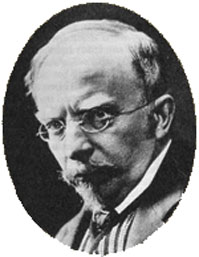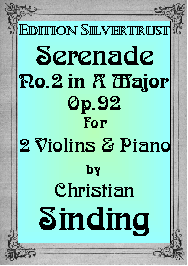Presents
Christian Sinding
 |
|
Serenade No.2 for 2 Violins & Piano in A Major , Op.92
 The
Serenade No.2 by Christian Sinding (1856-1941) followed his first such
composition by seven years and was no doubt inspired in part by the tremendous
success the first enjoyed. Sinding's
two serenades for two violins and piano, while not the only works for this
combination, are widely regarded as among the best of the
romantic repertoire. His ability to draw tremendous tonal color from two soprano
instruments is truly surprising.
The
Serenade No.2 by Christian Sinding (1856-1941) followed his first such
composition by seven years and was no doubt inspired in part by the tremendous
success the first enjoyed. Sinding's
two serenades for two violins and piano, while not the only works for this
combination, are widely regarded as among the best of the
romantic repertoire. His ability to draw tremendous tonal color from two soprano
instruments is truly surprising.
Christian Sinding (1856-1941), along with Edvard Grieg came to symbolize Norwegian classical music between 1885 and 1940. Born is the small town of Kongsberg near Oslo, Sinding, after studying music in Oslo, attended the Leipzig Conservatory, where he studied violin with Henry Schradieck and composition with Salomon Jadassohn and Carl Reinecke. Whereas Grieg's style of writing has been described as Schumann's technique combined with Norwegian folk melody, Sinding's is often and incorrectly characterized as combination of Wagner's technique with Norwegian folk melody. Although the influence of Norwegian folk melody can be found in his music, Sinding did not use it, as did Grieg, so extensively. Rather, it was German romanticism, and in particular the music of Liszt and Wagner, which greatly influenced Sinding. But unlike Liszt and Wagner, Sinding relied on wit and developed a more cosmopolitan style. Writing in virtually all genres, his chamber music must be considered an important part of his output.
Serenade No.2 dates from 1909. Like the First Serenade, it, too, is in five movements. The opening Allegro non troppo, is rather similar in mood to the opening of the First, upbeat and bright it uses the echo effect quite telling. The second theme begins as a lyrical melody but the seeds of its heroic treatment can clearly be heard. The introduction to the Andante sostenuto which follows, is warm, intimate and has a charming simplicity. The romantic second subject, somewhat dark in tone but not mood, soars. A wonderful, lilting Allegretto serves as an intermezzo between the two slow movements. The Adagio, which comes next, begins calmly with a warm and romantic melody which builds gradually to a climax which both stormy and dramatic. The finale, Deciso ma non troppo allegro, is gay and dance-like, untroubled in mood.
This is a great concert piece and, along with his First Serenade, one of the best works for this ensemble you will find. Certainly technically competent amateurs should not miss it. Very difficult to obtain, we are pleased to bring it back and hope that both professionals and amateurs will make its acquaintance.
Parts: $29.95